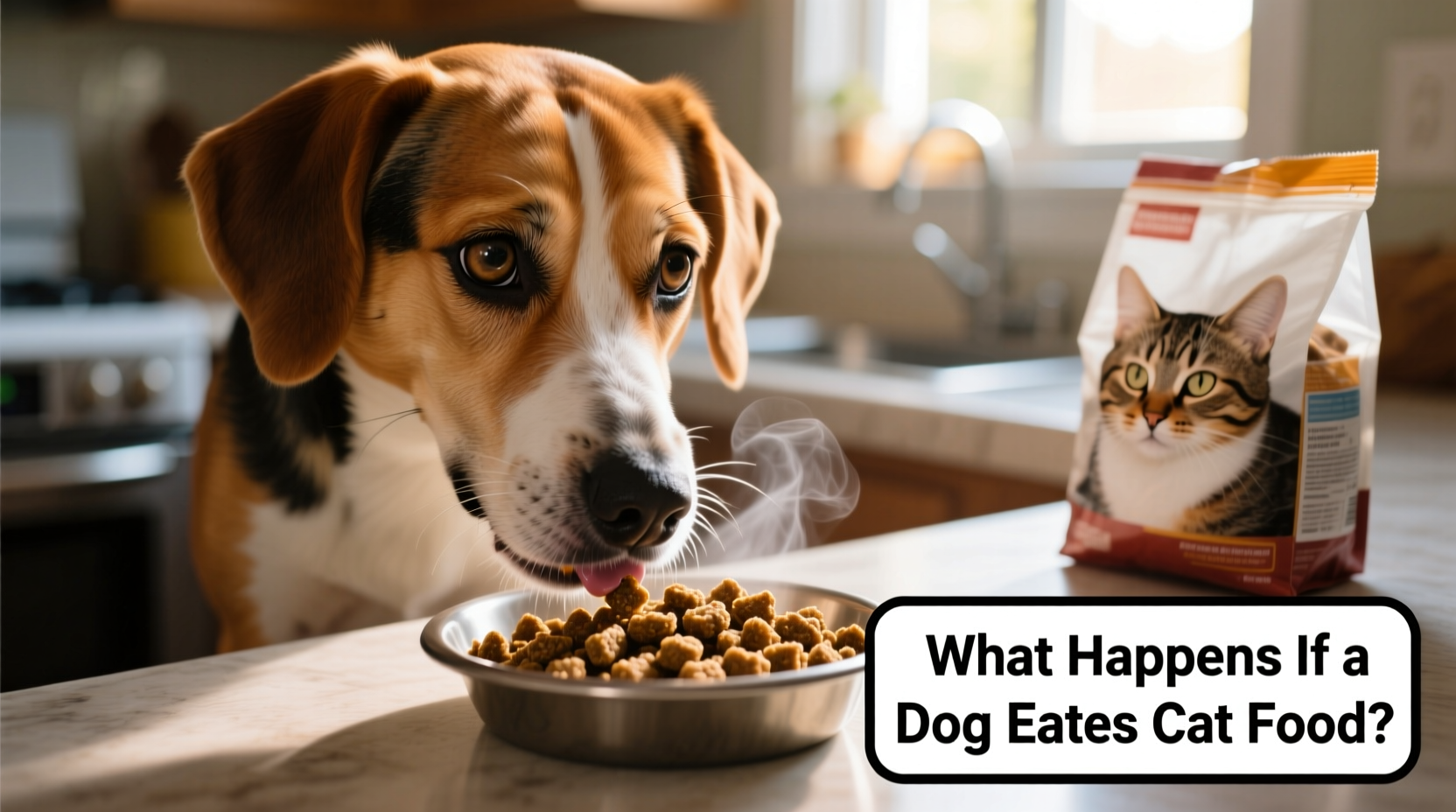Discover exactly what happens when your dog eats cat food, how to respond immediately, and when to contact your veterinarian. This comprehensive guide provides science-backed information to help you make informed decisions about your pet's nutrition and health.
Understanding the Immediate Effects
When your dog consumes cat food, the first concern is digestive distress. Cat food typically contains 30-40% more protein and significantly higher fat content than dog food, which can overwhelm your dog's digestive system. Most dogs experience mild symptoms within 6-12 hours:
- Nausea and decreased appetite
- Vomiting (often within 4-6 hours)
- Diarrhea or loose stools
- Increased thirst and urination
- Abdominal discomfort
According to the American Veterinary Medical Association, occasional consumption of cat food rarely causes serious issues in healthy adult dogs. However, puppies, senior dogs, and dogs with pre-existing health conditions face higher risks of complications from even small amounts of cat food.
Dog Food vs. Cat Food: Critical Nutritional Differences
| Nutrient | Dog Food Requirements | Cat Food Requirements | Risk to Dogs |
|---|---|---|---|
| Protein | 18-25% | 30-45% | Pancreatitis, kidney strain |
| Fat | 10-15% | 18-22% | Digestive upset, obesity |
| Taurine | Synthesized internally | Must be in diet | Generally safe in small amounts |
| Vitamin A | Moderate levels | High levels | Hypervitaminosis A with regular consumption |
| Niacin | Moderate levels | Very high levels | Potential toxicity with frequent consumption |
This nutritional comparison from the American Veterinary Medical Association highlights why cat food doesn't meet canine nutritional requirements. While dogs can synthesize certain nutrients like taurine that cats require in their diet, the reverse isn't true—cat food contains levels of certain nutrients that can be harmful to dogs when consumed regularly.
When to Contact Your Veterinarian Immediately
While most dogs recover from occasional cat food consumption without intervention, certain symptoms require immediate veterinary attention. Contact your vet if your dog shows:
- Repeated vomiting (more than 3 times in 8 hours)
- Blood in vomit or stool
- Severe lethargy or weakness
- Abdominal pain (whining, reluctance to move)
- Signs of dehydration (dry gums, sunken eyes)
- Difficulty breathing
Dogs with pre-existing conditions like pancreatitis, kidney disease, or diabetes face significantly higher risks when consuming cat food. The Cornell University College of Veterinary Medicine reports that dogs with these conditions can experience severe complications even from small amounts of cat food.
Step-by-Step Response Guide
If your dog eats cat food, follow these evidence-based steps to ensure their safety and comfort:
- Assess the situation: Determine how much cat food was consumed and when. Small amounts (less than 10% of daily food intake) typically cause minimal issues.
- Withhold food temporarily: For adult dogs, withhold food for 12 hours to allow the digestive system to rest, but always provide fresh water.
- Monitor closely: Watch for symptoms over the next 24-48 hours, especially during the first 12 hours when symptoms typically appear.
- Reintroduce food gradually: After the fasting period, offer small portions of bland food like boiled chicken and rice.
- Prevent future incidents: Store cat food out of reach, feed pets in separate areas, and consider puzzle feeders for cats.
Research from the Journal of Veterinary Emergency and Critical Care indicates that dogs who receive appropriate supportive care after consuming inappropriate foods have excellent recovery rates. Most dogs recover fully within 24-72 hours with proper management.
Long-Term Health Risks of Regular Cat Food Consumption
While occasional cat food consumption rarely causes lasting harm, regular consumption creates significant health risks. Dogs fed cat food consistently face:
- Pancreatitis: The high fat content in cat food (18-22% vs. 10-15% in dog food) significantly increases pancreatitis risk. This painful condition requires hospitalization and can be life-threatening.
- Nutritional imbalances: Cat food lacks sufficient vitamin D and certain B vitamins that dogs require, while containing excessive vitamin A that can cause bone problems over time.
- Obesity: The higher calorie density of cat food contributes to weight gain, especially in less active dogs.
- Kidney strain: The excessive protein load forces kidneys to work harder, potentially accelerating kidney disease in susceptible dogs.
A landmark study published in the Journal of Animal Physiology and Animal Nutrition found that dogs fed exclusively cat food for six months developed measurable deficiencies in key nutrients while showing elevated markers of metabolic stress. The researchers concluded that while occasional consumption poses minimal risk, cat food should never serve as a dog's primary food source.

Preventing Future Incidents
Preventing your dog from accessing cat food requires strategic planning. Consider these practical solutions:
- Feed cats in elevated areas inaccessible to dogs
- Use automatic feeders with microchip recognition for cats
- Implement scheduled feeding times rather than free-feeding
- Train your dog the "leave it" command for food items
- Use baby gates to create cat-only feeding zones
Behavioral studies show that dogs who consistently receive positive reinforcement for leaving cat food alone develop reliable self-control within 2-4 weeks of consistent training. This approach proves more effective than punishment-based methods, which can create anxiety around food.
What to Feed After Cat Food Consumption
After your dog eats cat food, proper nutrition during recovery supports healing. Follow this feeding timeline:
- First 12 hours: Water only (unless vomiting occurs, then consult vet before offering water)
- 12-24 hours: Small portions of bland diet (1 part boiled chicken to 2 parts white rice)
- 24-48 hours: Gradually reintroduce regular dog food (75% regular food, 25% bland diet)
- 48-72 hours: Return to normal feeding schedule with regular dog food
The American Kennel Club recommends adding a small amount of plain canned pumpkin (not pie filling) to your dog's bland diet, as the fiber helps regulate digestion. Always consult your veterinarian before making significant dietary changes, especially for dogs with pre-existing health conditions.











 浙公网安备
33010002000092号
浙公网安备
33010002000092号 浙B2-20120091-4
浙B2-20120091-4